As the US’ strategic focus shifts to the Asia-Pacific theatre, conventional helicopters may not be enough. The vast distances of the region are driving innovation in military heavy-lift rotorcraft, toward development of platforms that can fly faster and farther than today’s workhorses.
While the future efficacy of operating light battlefield helicopters has in recent years been called into question, most obviously due to the heavy cost paid by Russian helicopters in the early stages of the 2022 full-scale invasion of Ukraine, and the emerging dominance of armed unmanned aerial vehicles (UAVs) and loitering munitions in that conflict and others, the future for heavy-lift rotary-wing platforms is much more assured.
Operating often behind the immediate battlefront, heavy-lift helicopters can be used to rapidly deploy meaningful loads of troops and equipment, including light tactical vehicles and artillery pieces, into forward areas well beyond available airstrips, while additionally being a platform of choice for special forces insertion. Regarding the heavy-lift rotorcraft market for Western countries and their allies, there are two top dogs currently in production: the latest versions of the Boeing CH-47 Chinook and the Sikorsky CH-53.
The CH-47F Block II
The very first CH-47 Chinook made its maiden flight – somewhat remarkably, given the type’s continued primacy – back on 21 September 1961. Over the following 60 years, successively enhanced models of the Chinook were procured by the US Army and the armed forces of around two dozen other countries.
The Chinook’s tandem rotor design offers a number of key advantages: a broad centre-of-gravity range for both internal and external loads, a high degree of wind tolerance compared to other helicopters and no tail rotor complications such as drift, roll or reductions in effectiveness, given that it doesn’t have one.
Development of the CH-47F Block II, meanwhile, began in 2017 and the type made its first test flight in 2019. Featuring a fully integrated digital cockpit management system – the Common Avionics Architecture System (CAAS) cockpit paired with a Digital Automatic Flight Control System (DAFCS) – the CH-47F Block II also features redesigned fuel tanks, a strengthened fuselage, an improved drivetrain, advanced cargo-handling capabilities and can be fitted for air-to-air refuelling, as requested by Germany. Powered by two Honeywell T55-GA-714A engines each offering 3,529 kW (4,777 shp), the CH-47F Block II has a maximum speed of 302 km/h, a service ceiling of 6,096 m (20,000 ft), a maximum gross weight of 24,494 kg and a useful load of 12,565 kg. With these latest-model Chinooks intended to serve into the 2060s, the type will by that point have clocked up an incredible 100-year service life.
Thus far, the US Army has 51 Block II Chinooks under contract in the form of MH-47G Block IIs ordered for US Army Special Operations Aviation Command (USASOAC). These remanufactured aircraft are scheduled to be delivered from 2027 and, as per their special forces remit, incorporate a number of additional features compared to the standard CH-47F Block II: an in-flight refuelling probe, an enhanced defensive aids suite, low-level/adverse weather piloting aids such as forward-looking infrared and multi-mode/terrain-following radar along with an armament consisting of two 7.62 mm M134 Miniguns and two M240 7.62 mm machine guns. Manufacturer Boeing has stated that it expects to finalise the entire USASOAC Chinook fleet by early 2030.
Beyond the US Army, the CH-47F Block II also has international customers: in February 2024 it was announced that Germany had placed an initial order for what will eventually be 60 modified aircraft; in February 2025 Japan ordered 17, which will be co-produced by Boeing and Kawasaki Heavy Industries (just as with previous Chinooks procured for the Japan Self-Defense Forces); and in May 2025 the UK Ministry of Defence confirmed an expected order, first signalled in 2021, for 14 new-build MH-47G Block II Chinooks, still referred to as ‘H-47ERs’.
The CH-53K King Stallion
The first example of the original CH-53 Sea Stallion, meanwhile, made its maiden flight on 14 October 1964 and entered service with the US Marine Corps (USMC) in 1966. Versions of the CH-53 were subsequently ordered for the armed forces of Germany, Israel, Iran, and Austria, while Mexico briefly purchased and operated four former Israeli airframes.
Development of the latest CH-53K King Stallion was contracted by the USMC in 2006, with the model’s first flight taking place on 27 October 2015 and an initial operational capability with the aircraft declared by the USMC on 22 April 2022.
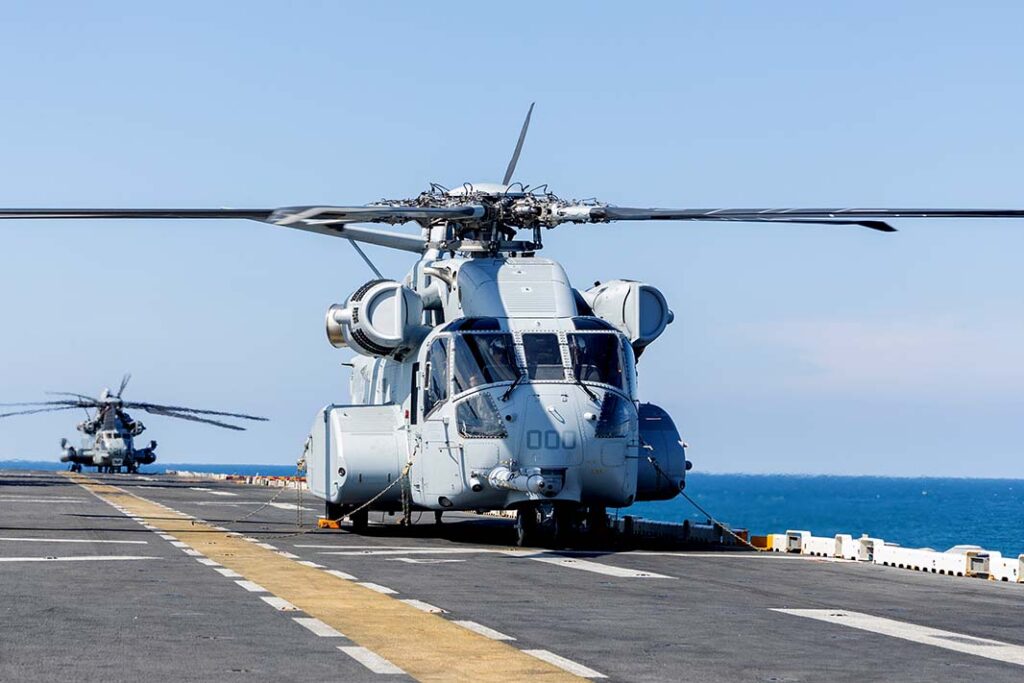
Powered by three General Electric T408 (GE38-1B) turboshafts each developing 5,600 kW, the CH-53K is claimed by Lockheed Martin/Sikorsky to be able to lift three times the load of its CH-53E predecessor. Its payload is 15,876 kg for an internal load or 16,329 kg for an external load. The aircraft has a cruise speed of 310 km/h, a service ceiling of 4,900 m (16,000 ft; International Standard Atmosphere) and a combat range of 200 km (although it also features a refuelling probe). According to US Naval Air Systems Command (NAVAIR), the CH-53K can carry 12,247 kg to a mission radius of 203 km (110 NM) in high/hot environments, “which is almost triple the baseline of the CH-53E”.
Designed to transport heavy equipment and supplies during ship-to-shore movement in support of amphibious assault and subsequent operations ashore, the CH-53K is the heaviest helicopter in the US military and is billed by NAVAIR as the US military’s most powerful rotorcraft.
By 26 September 2025, when Lockheed Martin’s Sikorsky business announced a USD 10.855 billion (EUR 9.25 billion) multi-year procurement deal to build up to 99 CH-53Ks, Sikorsky had delivered 20 CH-53Ks to the USMC, with an additional 63 aircraft in various stages of production and assembly. The USMC’s current procurement objective stands at 200 CH-53Ks.
Beyond the US military, on 31 December 2021 it was announced that Israel had signed a deal to buy 12 CH-53Ks. While the German Ministry of Defence had initially considered a purchase of CH-53Ks to replace its current fleet of CH-53Gs under the Schwerer Transporthubschrauber (STH) heavy-lift helicopter programme, in September 2020 Germany instead opted to procure the CH-47F Block II instead.
What comes next?
While procurement of the CH-47F Block II and CH-53K King Stallion continues apace, plans for what will come after them are somewhat opaque. For now the US Army’s focus is on the development and fielding of the Bell MV-75 tiltrotor, which, developed from the V-280 Valor demonstrator, was selected in 2022 to fulfil the army’s Future Long Range Assault Aircraft (FLRAA) requirement under its overarching Future Vertical Lift (FVL) modernisation programme.
The US Army did embark on a study to consider a future heavy vertical lift replacement for the CH-47 in 2023, which was apparently concluded in 2024, but that report has not been published. Moreover, while ESD has pitched questions on future rotary-wing heavy-lift plans to the US Army’s FVL Cross-Functional Team, the US government shutdown that began on 1 October 2025 and continues as of this writing has curtailed US Army media operations and no response has been received. However, discussions with a couple of eminent sources with regard to military rotorcraft have illuminated some potential future paths.
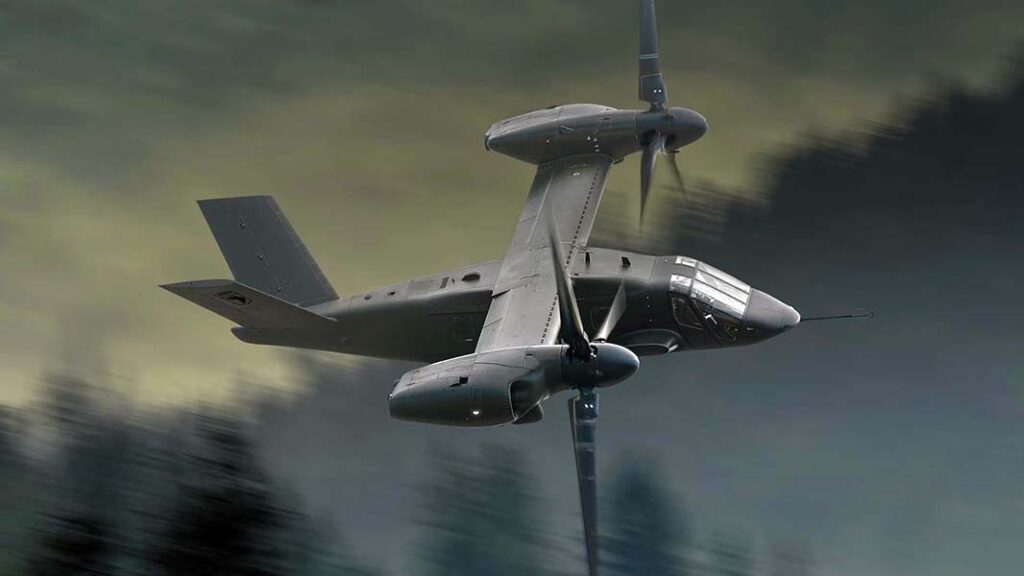
As previously mentioned, the US Army has only procured the CH-47F Block II – in the form of remanufactured MH-47G Block IIs – for USASOAC, the stated reason for this being that the army is preserving its funding to invest in Capability Sets (Cap Sets) for the FVL portfolio – even though a heavy-lift solution within that might not be fielded until the 2060s.
On the eve of the 2025 Association of the US Army exposition (AUSA 2025), held in Washington, DC, in October, ESD spoke with Paul ‘Foo’ Kennard, who served for 23 years in the UK Royal Air Force as a CH-47 pilot and has now become a highly regarded military aviation consultant and journalist. Kennard suggested that, for reasons that are both political and strategic, the US Department of Defense (or Department of War, as current US Defense Secretary Pete Hegseth would have it called) will not wish to have Boeing’s Chinook production facility in Ridley Park, Pennsylvania, reduced to a single line. The political reason stems from the fact that the CH-47’s supply chain covers manufacturers in dozens of Congressional districts; the strategic reason is because a significant number of skilled workers would have to be laid off and that capacity could not be easily regenerated.
In an article published in Antares magazine in early 2025 entitled ‘Chinook, Future Imperfect?’ – a feature that won the inaugural Andrew Drwiega Award for the Best Rotorcraft Submission at the 2025 Defense Media Awards – Kennard suggested a number of options for upgrading the US Army’s roughly 500-strong Block I CH-47F fleet. These range from adopting some of the more easily transposable enhancements found in the Block II aircraft, to resurrecting plans for the Advanced Chinook Rotor Blade (which would have significantly improved lift performance but were abandoned to excessive vibration discovered during flight testing), to going for an up-engining programme. Regarding the latter, Kennard noted there would be two options: a more powerful version of the current Honeywell T55 engine designated the T55-714C; or adoption of the CH-53K’s General Electric T408 turboshaft, which would offer close to a 60% power hike over the current T55-714A powerplant.

Kennard cautioned, however, that both of these up-engining options would provide more power than the current Chinooks’ transmissions and drivetrain have been designed for. While this could be mitigated by restricting the Chinook’s transmission system or controlling the new powerplants via the Chinook’s flight control system, it would seem to be waste to fit significantly uprated engines that could not be fully exploited. Other potential upgrades that Kennard noted in his Chinook feature included previously considered redesigns, such stretching the aircraft’s fuselage to accommodate a wing box that would allow the installation of lift compounding wings.
More than a helicopter
However, if the US military is to continue seriously addressing the ‘Pacific Pivot’ first announced by President Barack Obama in November 2011 – the strategic refocusing of US military capability on the Asia-Pacific to contain the increasing military power projection of China – then one thing is clear: the tyranny of distance will prevail. For the future of heavy-lift rotorcraft this means that an effective solution with the range and speed required to successfully operate in the Asia-Pacific region simply cannot be a conventional helicopter.
On 14 October at AUSA 2025 ESD sat down for a discussion with aerospace consultant Bill Lewis. After serving as a US Army officer for 22 years, primarily on aviation and acquisition assignments and as a test pilot, Lewis moved initially into academia before becoming a key figure in the development of US military rotorcraft programmes. Most notably, in 2012 Lewis became the director of the US Army Aviation Development Directorate, and in that capacity initiated the US Army’s Joint Multi-Role (JMR) rotorcraft programme: a technology demonstration effort that then folded into the larger FVL initiative.
Asked what he was looking for when addressing the heavy-lift aspect of the JMR/FVL initiative – what is known within the US Army as Capability Set (‘Cape Set’) Four – Lewis explained, “We were looking at the requirements completely differently than historically we’d looked at the requirements. In other words, we weren’t trying to support a divisional force along a division front, say 100 nautical miles (185 km); we were trying to deploy a manoeuvre force across continents to get to a fighting position or a sustainment position, at speed with mass that mattered.”
“I did a whole study and I came up with a briefing, and the title of the briefing was ‘It’s the distance, stupid’, because a lot of the aircraft we have today can’t get there,” said Lewis. “If they don’t have probes, if they don’t come on ships, if they don’t come on airplanes, they’re not getting there. So we wanted an aircraft that could do all of that: deploy from CONUS (the continental US), Alaska, Hawaii, wherever … all without a probe refuel.” He added, “Fundamentally, we wanted to be able to get that distance, the tyranny of distance, mitigated. In order to do that, you’ve got to come up with configurations that allow you to get a lot of aerodynamic efficiencies.”

Lewis further explained the essential truth that “you don’t get range without speed; you don’t get range if you don’t get an aircraft up on wing”. Asked if this means the solution is likely to be a tiltrotor design, Lewis replied, “It doesn’t have to be a tilt rotor. It can be a tilt wing. It can’t be an edge-wise rotor. There are configurations other than tilt rotor, but to try to struggle to do it with a compound (helicopter), with an edge-wise rotor, becomes very problematic – unless you have a way more complicated design, unless you have a way to get an edgewise rotor up on wing and then stop the rotor so that it’s not draggy. So now you’re talking some more complexity; physics are fighting you from that perspective.”
Lewis further recalled that, although he and his team looked at quad tiltrotors, they ultimately decided that a bigger twin-engined tiltrotor – larger than the Bell-Boeing V-22 Osprey – could potentially accomplish the mission. The current V-22 has a maximum internal capacity of 9,100 kg, a maximum speed of 565 km/h at 4,600 m (15,000 ft), combat range of 720 km and a ferry range of 4,130 km (although it does feature a refuelling probe). “Once you go quad, you’re talking a lot of complexity, a lot of lot of additional weight, and it’s big,” said Lewis, “so we were trying to keep it as simple as possible and keep it as small as possible.” He also noted that any additional measures to improve aerodynamic efficiency make a difference, along with minimising the external installation of opto-electronic turrets or weapons that cause drag.
Lewis said that his team was also attempting to eliminate the need for both aerial refuelling, which requires accompanying sorties from tanker aircraft, and forward arming and refuelling points (FARPs), which on the modern battlefield would be increasingly exposed to hostile long-range fires. “I think the loneliest guy on the battlefield is the dude that’s protecting the FARP after everybody’s left, right? He’s out there in the middle of no man’s land with nobody to help him,” Lewis observed.
SPRINT: a potential way forward
In late 2023 the US Defense Advanced Research Projects Agency (DARPA), in a joint effort with US Special Operations Command, initiated the Speed and Runway Independent Technologies (SPRINT) project. Its aim is to design, build, and fly an X-plane to demonstrate the key technologies and integrated concepts that enable a transformational combination of aircraft speed and runway independence. The ultimate SPRINT goal is to design a high-speed vertical take-off and landing (HSVTOL) X-plane with the ability to cruise at speeds from 741-833 km/h (400-450 kn) at cruise altitudes and to hover in austere environments, taking off from and landing on unprepared surfaces.
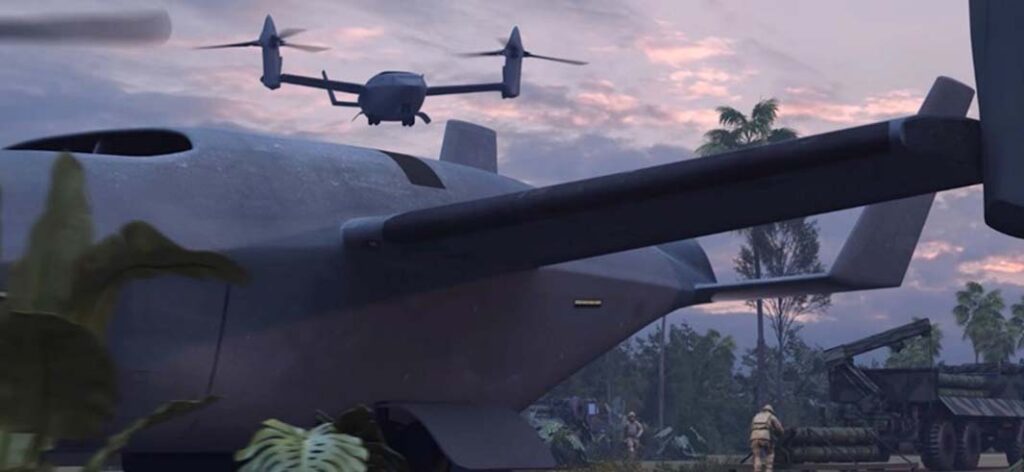
While in May 2024 two performers – Aurora Flight Sciences and Bell Textron – were awarded contracts for Phase 1B of the programme, under which they had a year to complete preliminary design work, in June 2025 Bell Textron was awarded the sole contract for Phases 2 and 3, under which a SPRINT X-plane will be designed, built and flight-tested.
Bell’s HSVTOL solution for SPRINT incorporates a stop/fold rotor system in which a pair of tilting rotors are used by the aircraft to take off and land vertically, but are ultimately stowed away for horizontal flight to minimise drag as a jet propulsion system takes over. In December 2024 Bell announced that it had completed wind tunnel testing of the concept at the National Institute for Aviation Research (NIAR) at Wichita State University, having initially evaluated the stop/fold rotor system at the Holloman Hish Speed test Track in new Mexico in 2023.
Given that this technology is meant to be scalable from smaller uncrewed aircraft to larger platforms, the advent of a heavy-lift variant certainly appears likely.
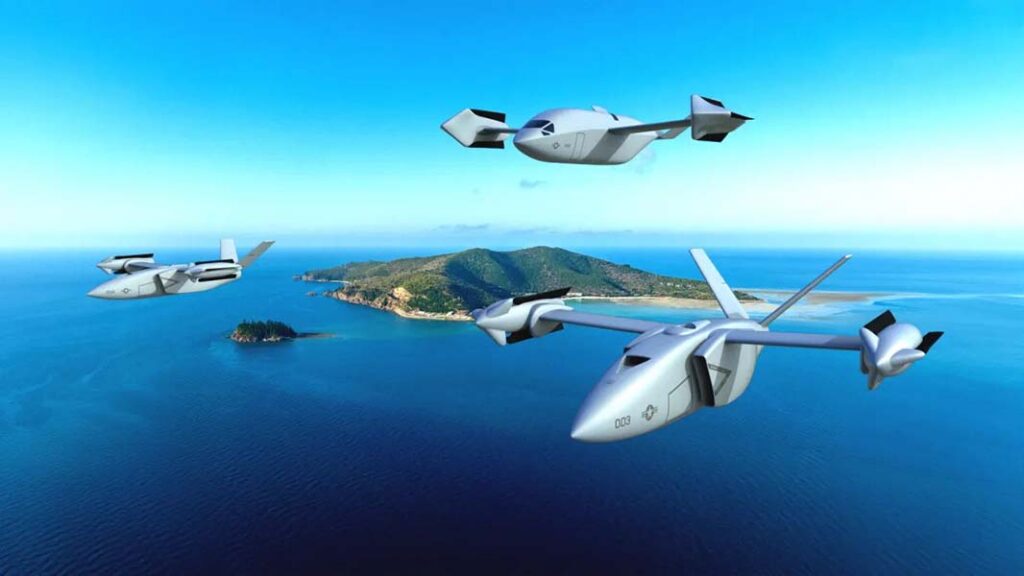
Beyond the US
Of the broadly historically US-aligned countries worldwide that operate a heavy-lift rotorcraft capability, all are dependent on US-designed platforms. Australia, Canada, Egypt, Germany, Greece, India, Italy, Japan, South Korea, Morocco, the Netherlands, Saudi Arabia, Singapore, Spain, Taiwan, Turkey, the United Arab Emirates and the United Kingdom all operate various models of the CH-47; while Germany and Israel still operate CH-53s.
Iran, which received around 100 CH-47Cs prior to the country’s Islamic revolution in 1979, is believed to be still operating about 40 of these despite US sanctions, according to the 2025 FlightGlobal World Air Forces directory (the International Institute of Strategic Studies’ The Military Balance 2025 puts this figure at around 22). Iran is possibly also still keeping airworthy a small number of the US RH-53D Sea Stallions it received prior to 1979, according to some sources. Meanwhile, the operational status of a pair of CH-47Cs in divided Libya is currently unknown.
The only Western European-designed helicopter that had a payload capacity even approaching the heavy-lift category was the French Aerospatiale SA 321 Super Frelon, which had an internal payload of 4 tonnes (or 5 tonnes for an external payload). However, the Super Frelon was retired from French Navy service in 2010 and none of its export customers still operate the type. While NATO’s Next-Generation Rotorcraft Capability initiative is looking at replacing Europe’s medium rotorcraft fleets, there seems to be no discernible plan for a future European heavy-lift rotorcraft.
In Russia the prime military heavy-lift rotary-wing platform currently in service is the Mil Mi-26, which is generally billed as the world’s heaviest-lifting helicopter and first flew on 14 December 1977, with the first production aircraft rolled out on 4 October 1980. Powered by two Ivchenko-Progress (formerly OKB-478/Ivchenko Lotarev) D-136 turboshafts each offering a power output of 8,500 kW, the Mi-26 can carry a payload of up to 20 tonnes – exceeding the lift capabilities of the latest US heavy-lift platforms.
An upgraded version developed in the 1990s, the Mi-26M, powered by two Ivchenko-Progress D-127 turboshafts each offering a power output of 10,800 kW, did not end up entering service. However, other upgraded versions have emerged since, most notably the Mi-26T2V, which features modern avionics with a glass cockpit, and the ‘Vitebsk’ defensive aids suite, made its maiden flight in August 2018. A contract for a batch of 10 Mi-26T2Vs was reported by topwar.ru to have surfaced in March 2019. Topwar.ru also reported around October 2023 that following trials, the Russian armed forces had already begun to receive their first serially produced Mi-26T2Vs.
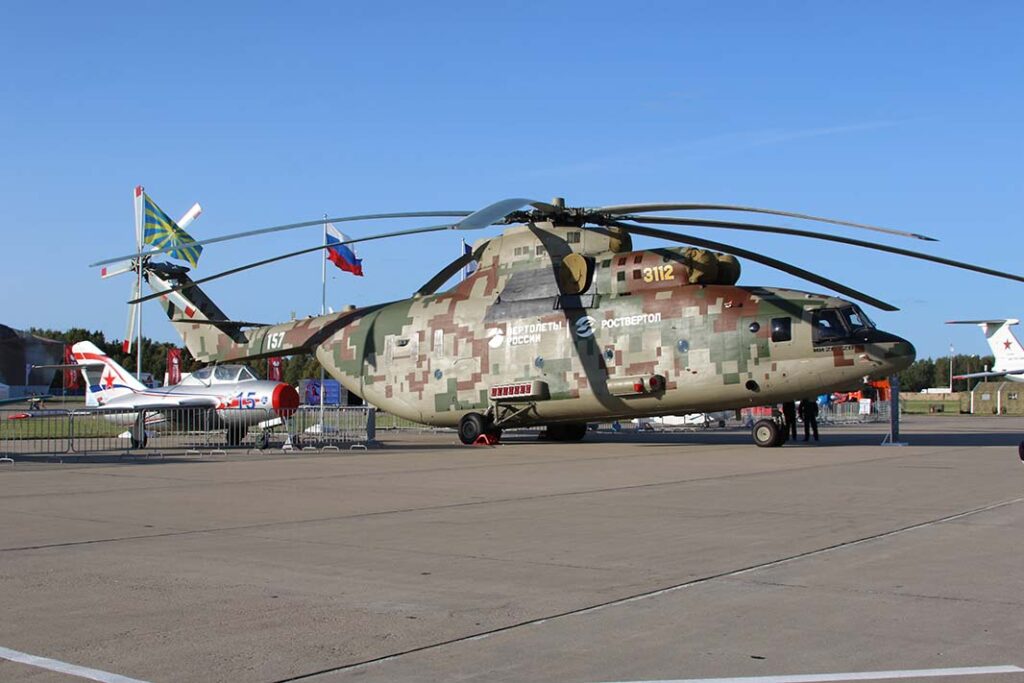
At this point it is worth noting that Ivchenko-Progress ZMKB, the previous engine provider for the Mi-26 family, is a Ukrainian company based in Zaporizhzhia, on the front line of the Ukraine War. Russia’s full-scale invasion of Ukraine in 2022, thus complicated Moscow’s ability both to maintain its Mi-26 fleet and to advance any future heavy-lift rotorcraft plans. However, back in 2018, Russian news sources reported that in response to sanctions imposed in 2014, Russia aimed to re-engine its Mi-26s with the then under-development PD-12V engines from the Russian powerplant company Aviadvigatel. Flight tests were planned for 2023, and delivery of an initial batch in 2025. Aviadvigatel claimed back in April 2016 that the PD-12V, which at the time was projected to have a power rating of 14,000 hp (10,440 kW), would be “the most powerful turboshaft engine in the world”.
However, in 2022, Russian news sources reported that the plan had changed, in spring of that year, with the decision made to adopt the PD-8V engine instead. Initially, the move was assumed to indicate that Mi-26s would receive a weaker engine than initially planned, but some Russian reports, citing Russia’s United Engine Corporation (ODK), have claimed that the PD-8V would match the intended performance of the PD-12V, and would ultimately provide a 15% power uplift from the older D-136. Despite the claims published thus far, no official figures have yet been released to confirm the claimed performance figures, making the final picture somewhat unclear.
According to the International Institute of Strategic Studies. 2025 edition of The Military Balance, the Russian Aerospace Forces currently operate 33 Mil Mi-26 heavy-lift helicopters, while the FlightGlobal 2025 World Air Forces directory lists 45 Mi-26s with 15 on order. The Mi-26 was also exported to the armed forces of more than a dozen other countries, with a number of these still operating the type: Algeria, Equatorial Guinea, Jordan, Kazakhstan, North Korea and Venezuela.
Regarding China in the slightly sub-heavy-lift category, the various service arms of China’s People’s Liberation Army (PLA) operate numerous Z-8/Z-18 helicopters (around 130 according to FlightGlobal, while other estimates put the figure at more than 100), which are Chinese versions of the French Super Frelon. By 2021, according to reports by China’s state-run Global Times news outlet, an enhanced Z-8L variant had entered service featuring a wider body; new types of optoelectronic pods, radar warning receivers and infrared decoys; and offering a heavier payload. The Z-8G/Z-18, according to reporting by Aviation International News, can carry five tonnes of cargo for up to 1,000 km.
In terms of China and Russia’s future heavy-lift rotorcraft plans, the Aviation Industry Corporation of China (AVIC) is developing a new Advanced Heavy Lifter (AHL) helicopter in conjunction with Moscow-headquartered Russian Helicopters, with a contract covering this work signed in November 2021. This project was originally envisioned as a joint venture, although Russian Helicopters now appears to have been relegated to being a subsystem provider. With a maximum take-off weight of 38.2 tonnes, the AHL is expected to be able to accommodate a 10 tonne internal payload or a 15 tonne payload externally, have a practical ceiling of 5,700 m, a maximum speed of 300 km/h and a range of 630 km, according to reporting by the Russian RuAviation website in May 2024.
The AHL was expected to make its first flight in 2025, but as of the time of writing this does not appear to have occurred, with Russian participation perhaps compromised by the country’s invasion of Ukraine in February 2022, either through Western sanctions or Russian industry now having other priorities. To power the AHL, China was originally going to choose between two turboshafts – the Ukrainian D-136 or the Russian PD-12V – but in light of Russia’s switching to the PD-8V for its Mi-26 fleet, it is possible that this engine will end up equipping the AHL.
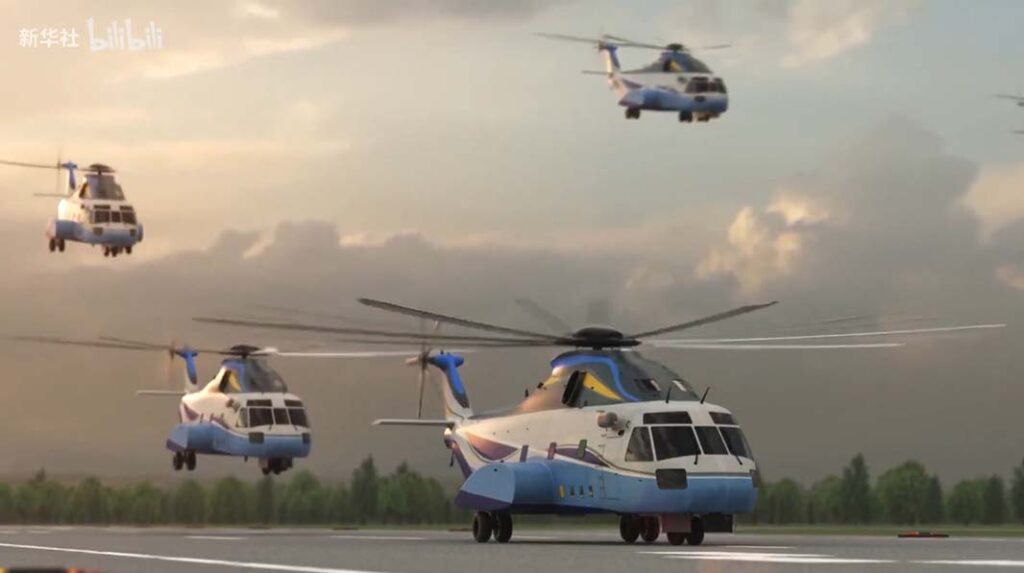
If the AHL is successfully developed, however, it is worth noting that it will still be a conventional helicopter, even if it turns out to be a very powerful one. Given that China, in its pressing for regional hegemony in the Asia-Pacific, will face similar ‘tyranny-of-distance’ issues that that US military has acknowledged it must confront in that theatre, a conventional helicopter might not be enough.
Closing thoughts
Returning to US manufacturers, at the moment the discussion space surrounding concepts for future rotorcraft-based heavy-lift platforms appears somewhat quiet; while ESD approached all the likely potential US primes for such a solution, asking them for their thoughts and potential concepts, only Bell was forthcoming.
“We believe high-speed vertical lift tactical airlift platforms have the potential to radically disrupt modern combat operations by greatly enhancing the ability of joint commanders to rapidly deploy and resupply forces across a widely distributed and contested battlespace,” a Bell spokesperson told ESD on 21 October 2025. They added, “With airfields as obvious targets, runway independence not only ensures the ability to operate under fire, but also allows for effective support to dispersed elements offset from available runways – complicating adversary targeting calculus. Special operations forces in particular would greatly benefit from the speed, range and signature improvements of such platforms relative to current vertical-lift capabilities.”
The need for a future VTOL platform with the requisite range, speed and lift capabilities to overcome the tyranny of range in the Asia-Pacific region is surely overwhelming, just as any future requirements for smaller manned battlefield reconnaissance rotorcraft are increasingly evaporating. “I guarantee: if the war in the Pacific starts, everybody’s going to wish that we had a whole bunch of Cape Set Fours,” Lewis told ESD.
With hindsight, and referencing the US Army’s Future Attack Reconnaissance Aircraft (FARA) programme under the FVL effort, which was initiated in 2018 but then terminated in 2024 to become the fourth US battlefield reconnaissance helicopter programme to suffer that fate, Lewis remarked, “In my view, we shouldn’t have done FARA; we should have done Cape Set Four – because unmanned platforms could do a lot of what FARA would have done, but there’s no substitute for what Cape Set Four would deliver.”
Peter Felstead


